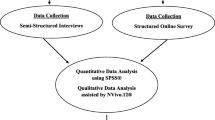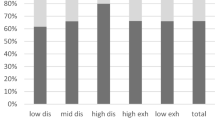Abstract
Purpose
The present study evaluates health status and its relation with occupational characteristics and with burnout syndrome among embryologists.
Methods
A cross-sectional design was used to conduct an online self-assessment survey, sent to all members of the Spanish Association of Clinical Embryologists. The questionnaire contained occupational questions and two standard instruments: ‘Short Form-12 Health Survey’ as a measure of physical (PCS-12) and mental (MCS-12) health and the Maslach Burnout Inventory-General Survey (MBI-GS) to evaluate the degree of burnout.
Results
The PCS-12 obtained for the Spanish embryologists was higher than that for the reference population. However, the total MCS-12 was significantly lower than that observed in non-institutionalised males and females representative of the general Spanish population aged 35–44 years. In the linear regression model, the dependent variable PCS-12 was related indirectly with the variables number of hours worked per week, BMI, back pain, leg pain and visual discomfort. In the linear regression model, the dependent variable MCS-12 was indirectly related to the gender (male reference; female coefficient regression: −3.23), exhaustion and cynicism dimensions of the MBI-GS. A total of 87 (36.3 %) embryologists presented a high score on at least one of the MBI-GS dimensions.
Conclusion
In this sample of Spanish embryologists, a norm measure (SF-12) showed their physical health to be better than the average for the general population, but that their mental health was poorer. A significant indirect relation was observed between mental health and burnout syndrome. Strategies to reduce occupational stress and problems should form part of the training provided for clinical embryologists.

Similar content being viewed by others
References
Maslach C, Jackson SE. The measurement of experienced burnout. J Occup Behav. 1981;2:99–113.
Maslach C, Schaufeli WB, Leiter MP. Job burnout. Annu Rev Psychol. 2001;52:397–422.
Balch CM, Freischlag JA, Shanafelt TD. Stress and burnout among surgeons; understanding and managing the syndrome and avoiding the adverse consequences. Arch Surg. 2009;144:371–6.
Adams S, Györffy Z, Susanszky E. Physician burnout in Hungary: a potential role for work family conflict. J Health Psychol. 2008;13:847–56.
Fontán IM, Dueñas JL. Burnout syndrome in an obstetrics and gynaecology management unit. Rev Calid Asist. 2010;25:260–7.
Ware Jr J, Kosinski M, Keller SD. A 12-Item Short-Form Health Survey: construction of scales and preliminary tests of reliability and validity. Med Care. 1996;34:220–33.
Fritzsche FR, Ramach C, Soldini D, Caduff R, Tinguely M, Cassoly E, et al. Occupational health risks of pathologists–results from a nationwide online questionnaire in Switzerland. BMC Public Health. 2012;12:1054–66.
Schaufeli WB, Leiter MP, Maslach C, Jackson SE. The Maslach Burnout inventory-general survey. In: Maslach C, Jackson SE, Leiter MP, editors. Maslach burnout inventory manual. Palo Alto: Consulting Psychologists Press; 1996. p. 19–26.
Gil-Monte PR. Factorial validity of the Spanish adaptation of the Maslach Burnout Inventory-General Survey. Salud Publica Mex. 2002;44:33–40.
European Foundation for the Improvement of Living and Working Conditions: http://www.eurofound.europa.eu/surveys/smt/ewcs/ewcs2010_07_07.htm.
Vilagut G, Valderasa JM, Ferrera M, Garina O, López-García E, Alonso J. Interpretación de los cuestionarios de salud SF-36 y SF-12 en España: componentes físico y mental. Med Clin (Barc). 2008;130:726–35.
Bresó E, Salanova M, Schaufeli W, Nogareda C. NTP 732: Sindrome de estar quemado por el trabajo “Burnout” (III): Instrumento de medición. INSHT. Ministerio de Trabajo y Asuntos Sociales, España. 2003. http://www.insht.es/InshtWeb/Contenidos/Documentacion/FichasTecnicas/NTP/Ficheros/701a750/ntp_732.pdf Last accessed 8 August 2013.
Frank E. Physician health and patient care. JAMA. 2004;291:637.
Thompson SK, Mason E, Dukes S. Ergonomics and cytotechnologists: reported musculoskeletal discomfort. Diagn Cytopathol. 2003;29:364–7.
Hartvigsen J, Lings S, Leboeuf-Y de C, Bakketeig L. Psychosocial factors at work in relation to low back pain and consequences of low back pain; a systematic, critical review of prospective cohort studies. Occup Environ Med. 2004;61:e2.
Punnett L, Wegman DH. Work-related musculoskeletal disorders: the epidemiologic evidence and the debate. J Electromyogr Kinesiol. 2004;14:13–23.
Lorusso A, Bruno S, Caputo F, et al. Risk factors for musculoskeletal complaints among microscope workers. G Ital Med Lav Ergon. 2007;29:932–7.
Kawada T, Ooya M. Workload and health complaints in overtime workers: a survey. Arch Med Res. 2005;36:594–7.
Krantz G, Berntsson L, Lundberg U. Total workload, work stress and perceived symptoms in Swedish male and female white collar employees. Eur J Public Health. 2005;15:209–14.
Yancy Jr WS, Olsen MK, Westman EC, Bosworth HB, Edelman D. Relationship between obesity and health-related quality of life in men. Obes Res. 2002;10:1057–64.
Wee CC, Davis RB, Hamel MB. Comparing the SF-12 and SF-36 health status questionnaires in patients with and without obesity. Health Qual Life Outcomes. 2008;6:11–8.
Katz DA, McHorney CA, Atkinson RL. Impact of obesity on health-related quality of life in patients with chronic illness. J Gen Intern Med. 2000;15:789–96.
Gill SC, Butterworth P, Rodgers B, Mackinnon A. Validity of the mental health component scale of the 12-item Short-Form Health Survey (MCS-12) as a measure of common mental disorders in the general population. Psychiatry Res. 2007;152:63–71.
Voltmer E, Schwappach DL, Frank E, Wirsching M, Spahn C. Work-related behavior and experience patterns and predictors of mental health in German physicians in medical practice. Fam Med. 2010;42:433–9.
Bovier PA, Arigoni F, Schneider M, Gallacchi MB. Relationships between work satisfaction, emotional exhaustion and mental health among Swiss primary care physicians. Eur J Public Health. 2009;19:611–7.
Benson S, Hahn S, Tan S, Mann K, Janssen OE, Schedlowski M, et al. Prevalence and implications of anxiety in polycystic ovary syndrome: results of an internet-based survey in Germany. Hum Reprod. 2009;24:1446–51.
Abbott JA, Hawe J, Clayton RD, Garry R. The effects and effectiveness of laparoscopic excision of endometriosis: a prospective study with 2–5 year follow-up. Hum Reprod. 2003;18:1922–7.
West CP, Tan AD, Habermann TM, et al. Association of resident fatigue and distress with perceived medical errors. JAMA. 2009;302:1294–300.
Montero-Marín J, Araya R, Blazquez BO, Skapinakis P, Vizcaino VM, García-Campayo J. Understanding burnout according to individual differences: ongoing explanatory power evaluation of two models for measuring burnout types. BMC Public Health. 2012;12:922–33.
Wright JG, Khetani N, Stephens D. Burnout among faculty physicians in an academic health science centre. Paediatr Child Health. 2011;16:409–13.
Palmer-Morales Y, Prince-Vélez R, Searcy-Bernal R. Burnout syndrome associated factors in gynecologists. Ginecol Obstet Mex. 2007;75:379–83.
Yoon JD, Rasinski KA, Curlin FA. Conflict and emotional exhaustion in obstetrician gynaecologists: a national survey. J Med Ethics. 2010;36:731–5.
Trufelli DC, Bensi CG, Garcia JB, Narahara JL, Abrão MN, Diniz RW, et al. Burnout in cancer professionals: a systematic review and meta-analysis. Eur J Cancer Care (Engl). 2008;17:524–31.
Nienhaus A, Westermann C, Kuhnert S. Burnout among elderly care staff. A review of its prevalence. Bitusnsdcehsugtzesundheitsblatt-Gesund. 2012;55:211–22.
Roberts DL, Cannon KJ, Wellik KE, Wu Q, Budavari AI. Burnout in inpatient-based versus outpatient-based physicians: a systematic review and meta-analysis. J Hosp Med. 2013;8(11):653–64.
Gerber M, Brand S, Elliot C, Holsboer-Trachsler E, Pühse U, Beck J. Aerobic exercise training and burnout: a pilot study with male participants suffering from burnout. BMC Res Notes. 2013;6:78–86.
Buddeberg-Fischer B, Klaghofer R, Buddeberg C. Arbeitsstress und gesundheitliches Wohlbefinden junger Ärztinnen und Ärzte. Z Psychosom Med Psychother. 2005;51:163–78.
Peeters MCW, de Jonge J, Janssen PPM, van der Linden S. Work-home interference, job stressors, and employee health in a longitudinal perspective. Int J Stress Manag. 2004;11:305–22.
Dikkers JS, Geurts SA, Kinnunen U, Kompier MA, Taris TW. Crossover between work and home in dyadic partner relationships. Scand J Psychol. 2007;48:529–38.
Hämmig O, Bauer GF. Work-life imbalance and mental health among male and female employees in Switzerland. Int J Public Health. 2009;54:88–95.
Knecht M, Bauer GF, Klaghofer R, Buddeberg-Fischer B, Stamm M, Hämmig O. Work-life conflicts and health among Swiss physicians–in comparison with other university graduates and with the general Swiss working population. Swiss Med Wkly. 2010;140:w13063.
McMurray JE, Linzer M, Konrad TR, Douglas J, Shugerman R, Nelson K. The work lives of women physicians: results from the physician work life study. The SGIM Career Satisfaction Study Group. J Gen Intern Med. 2000;15:372–80.
Kaplowitz MD, Hadlock TD, Levine R. A comparison of web and mail survey response rates. Public Opin Q. 2004;68:94–101.
Heiervang E, Goodman R. Advantages and limitations of web-based surveys: evidence from a child mental health survey. Soc Psychiatry Psychiatr Epidemiol. 2011;46:69–76.
Castilla JA, Hernandez E, Cabello Y, Navarro JL, Hernandez J, Gomez JL, et al. Assisted reproductive technologies in public and private clinics. Reprod Biomed Online. 2009;19:872–8.
Ferraretti AP, Goossens V, Kupka M, Bhattacharya S, de Mouzon J, Castilla JA, et al. Assisted reproductive technology in Europe, 2009: results generated from European registers by ESHRE. Hum Reprod. 2013;28:2318–31.
Rowland ML. Self-reported weight and height. Am J Clin Nutr. 1990;52:1125–33.
Jefferey RW. Bias in reported body weight as a function of education, occupation, health and weight concern. Addict Behav. 1996;21:217–22.
Villanueva EV. The validity of self-reported weight in US adults: a population based cross-sectional study. BMC Public Health. 2001;1:11.
Tokuda Y, Hayano K, Ozaki M, Bito S, Yana H, Koizumi S. The interrelationships between working conditions, job satisfaction, burnout and mental health among hospital physicians in Japan: a path analysis. Ind Health. 2009;47:166–72.
Gil-Monte PR. Factorial validity of the Maslach Burnout Inventory (MBI-HSS) among Spanish professionals. Rev Saude Publica. 2005;39:1–8.
Acknowledgements
We would like to thank the ASEBIR executive committee and the staff of the ASEBIR secretariat. We also thank all the ASEBIR members for their cooperation.
Conflict of interest
None declared.
Author information
Authors and Affiliations
Corresponding author
Additional information
Capsule
Embryologists’ physical health status is better than that of a reference population. However, embryologists, especially women, present poor levels of mental health related to burnout syndrome.
This article is related to the Ph.D. Doctoral thesis by B. López-Lería.
Rights and permissions
About this article
Cite this article
López-Lería, B., Jimena, P., Clavero, A. et al. Embryologists’ health: a nationwide online questionnaire. J Assist Reprod Genet 31, 1587–1597 (2014). https://doi.org/10.1007/s10815-014-0352-7
Received:
Accepted:
Published:
Issue Date:
DOI: https://doi.org/10.1007/s10815-014-0352-7




